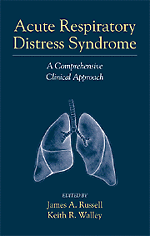Book contents
- Frontmatter
- Contributors
- Contents
- Preface
- Introduction
- 1 Overview, Clinical Evaluation, and Chest Radiology of ARDS
- 2 The Epidemiology of ARDS
- 3 The Pathology of ARDS
- 4 Cytokine -Induced Mechanisms of Acute Lung Injury Leading to ARDS
- 5 Pulmonary Pathophysiohgy in ARDS
- 6 Cardiovascular Management of ARDS
- 7 Mechanical Ventilation
- 8 Respiratory Muscles and Liberation from Mechanical Ventilation
- 9 Clinical Assessment and Total Patient Care
- 10 ARDS: Innovative Therapy
- 11 Nosocomial Pneumonia in ARDS
- 12 Resolution and Repair of Acute Lung Injury
- 13 Multiple System Organ Failure
- 14 Outcome and Long-Term Care of ARDS
- Index
5 - Pulmonary Pathophysiohgy in ARDS
Published online by Cambridge University Press: 05 October 2010
- Frontmatter
- Contributors
- Contents
- Preface
- Introduction
- 1 Overview, Clinical Evaluation, and Chest Radiology of ARDS
- 2 The Epidemiology of ARDS
- 3 The Pathology of ARDS
- 4 Cytokine -Induced Mechanisms of Acute Lung Injury Leading to ARDS
- 5 Pulmonary Pathophysiohgy in ARDS
- 6 Cardiovascular Management of ARDS
- 7 Mechanical Ventilation
- 8 Respiratory Muscles and Liberation from Mechanical Ventilation
- 9 Clinical Assessment and Total Patient Care
- 10 ARDS: Innovative Therapy
- 11 Nosocomial Pneumonia in ARDS
- 12 Resolution and Repair of Acute Lung Injury
- 13 Multiple System Organ Failure
- 14 Outcome and Long-Term Care of ARDS
- Index
Summary
Introduction
It is worthwhile to consider briefly the transport of oxygen from the air we breathe to the mitochondria. The first step of transport is just bulk flow of air into the lungs and ultimately into the alveoli so that oxygen is delivered to the alveolar capillary membrane. This bulk flow of oxygen is achieved by ventilation of the lungs. The next step in transport is diffusion of oxygen from the alveoli into blood contained within the pulmonary capillary bed. The pulmonary capillaries are different from the tubelike capillaries of the systemic circulation. Pulmonary capillaries are instead like sheets of blood surrounding air-filled alveoli, maximizing surface area for diffusion. Oxygen diffuses down a pressure gradient from the alveoli to the capillary blood where, for the most part, oxygen is bound to hemoglobin in red blood cells. The next step in gas transport is again bulk flow, accomplished by pumping blood by the heart from the lungs to the systemic capillary bed. Then oxygen diffuses from capillary blood across the capillary wall into the tissues. Oxygen content in many tissues is increased by the presence of oxygen-carrying molecules such as myoglobin. These molecules decrease the resistance to oxygen flow in the tissue beds and therefore facilitate diffusion of oxygen to even the most distant cells. Oxygen in the tissues then readily diffuses to the mitochondria where it acts as an electron acceptor for the electron transport chain at the final stage of ATP production.
- Type
- Chapter
- Information
- Acute Respiratory Distress SyndromeA Comprehensive Clinical Approach, pp. 80 - 106Publisher: Cambridge University PressPrint publication year: 1999



